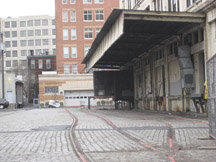Warehouses are to Jersey City what Victorian homes are to Cape May – the architectural signature that gives them their distinctive character, beyond bricks and wood and mortar. Jersey City’s storied industrial past haunts these cavernous structures, and preservationists want them protected with landmark status.
Recently, Jersey City’s Historic Preservation Commission voted to approve the nomination of five warehouses in the Powerhouse Arts District as local landmarks.
Now, they will go to a vote of the City Council. The council is scheduled to listen to public comments and vote on March 23.
The designation would mean that the buildings can’t be torn down and can only be altered in accordance with historic guidelines. All of them are privately owned, except the The Powerhouse, which is owned jointly by the city of Jersey City and the Port Authority of New York and New Jersey.
“They need to be protected from being altered beyond repair or torn down completely.” – John Gomez
________
“I hope it will be adopted,” said Planning Board Director Bob Cotter.
Two A& P warehouses
The Great Atlantic and Pacific Tea Company, better known to supermarket shoppers as A&P, had its warehouse at 144-158 Bay St. and an auxiliary building and bakery at 124-134 Bay Street, both built in the 1860s. According to John Gomez, a local historian with a master’s in Historic Preservation from Columbia University, they are important historically because A&P pioneered the supermarket concept in the 19th century. In addition, the main warehouse in Jersey City housed the company’s headquarters.
According to the company’s timeline, in 1907 the company moved its corporate headquarters from Manhattan to Jersey City at the site of its Eight O’Clock Coffee roasting plant, where the company remained for 20 years.
From an engineering standpoint, Gomez said, the warehouse headquarters “was one of the largest poured concrete structures in the world.” It was built by Turner Construction. “It was like a gigantic bunker, built to be fire and explosion proof,” he said. In those days, he said, boilers often exploded, and buildings often burned to the ground.
Butler Brothers
The Butler Brothers building at 344-350 Warren St. was a furniture warehouse built in the early 1900s. The E-shaped nine-story warehouse takes up almost an entire city block.
The company made and sold furniture. The building is from the Gilded Age. “It’s imposing with a beautiful medieval style,” Gomez said.
Designed by Jarvis Hunt, one of the greatest architects at the turn of the last century, it features corbelled cornices, parapets, decorative brick banding, and entirely brick bearing walls.
The corner of the Butler Warehouse along Washington Street is one of the proposed locations where the city would like to move an area Port Authority substation. Currently, the substation, which powers the PATH trains, is located in and adjacent to the Hudson and Manhattan Railroad Powerhouse building that the city would like to use as a focal point for an entertainment district.
Hudson and Manhattan Railroad Powerhouse
Better known as just the Powerhouse, this iconic structure may be the best known and most talked about building in Jersey City. The industrial age masterpiece is bounded by Bay, Washington, First, and Greene streets. Built between 1906 and 1908, the nine-story Romanesque Revival structure was designed by architect John Oakman.
The building is so sturdily constructed that it has withstood years of neglect. In the late 1990s, it was facing demolition, an event that spurred the creation of the Jersey City Landmarks Conservancy.
It was placed on the National Register of Historic Places in 2001. Just because a building is on a state or federal registry does not automatically put it on the city registry, Cotter said.
When the substation is moved, the construction of what will be known as the Powerhouse Arts District can begin. The district will be home to theaters, galleries, restaurants, and other arts and entertainment venues.
Merchants Refrigerating Company
Located at 124-142 First St., the Merchants Refrigerating Company warehouse was built in 1902 and was one of the largest refrigeration plants in the country. At the time, Gomez said, “a lot of people were buying manufactured ice, and gigantic boulders of ice could keep cold in there.” The building had electric refrigerators.
“It was the first big warehouse in the district,” Gomez said, “laying the groundwork for other mammoth buildings.”
What will become of them?
Obviously, landmark status does not mean that these giant structures have to go on being warehouses.
“It can mean adaptive reuse,” Gomez said. “They can be reused as a condo. It’s rare in this day and age” that a landmark building maintains its original use.
“The old court house is a rarity,” he said. “It was preserved and put back to its original use.” He’s referring to the Justice William Brennan Court House on Newark Avenue, built in 1910 and saved from the wrecking ball in the mid-1960s.
Gomez said that usually the original exterior is preserved, but it’s acceptable to build additions and alter some elements.
“As long as you don’t build a skyscraper on top or stucco them,” he said. “They need to be protected from being altered beyond repair or torn down completely.”
He said, “The city has to relay the message to property owners that it’s economically feasible to own a preserved landmark. Donald Trump can’t say that.”
Cotter said that if the five warehouses are approved for landmark status, that won’t automatically create a “warehouse district.”
“A consultant opined that too much had been demolished to make it a district,” Cotter said. “They will be individual landmarks.”
Kate Rounds can be reached at krounds@hudsonreporter.com..
